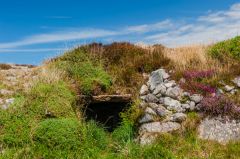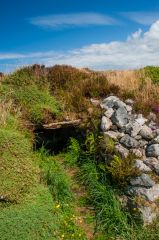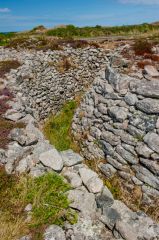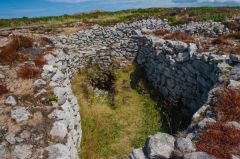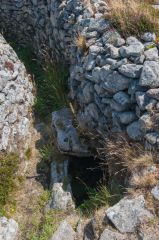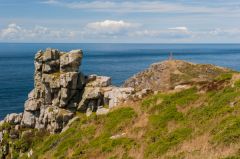
Ballowall Barrow is a prehistoric burial site in a marvellous clifftop location near St Just. Ballowall was used throughout the Neolithic and Middle Bronze Ages. The cairn, which is 67 feet in diameter, was concealed for many years beneath the spoilage of tin mining, but when finally excavated in 1878 revealed that the site was based around a round chambered cairn, entered by a covered gallery about 11 feet long.
Fragments of cremated bones and Bronze Age pottery was found beneath the passage floor. An unrelated burial cist is close to the entry gallery. At the centre of the cairn are four small ground-level cists, and a Bronze Age urn was found in one of the cists. A cist high in the mound contained a Roman coin, suggesting that the site was reused during the Roman period.
Finds excavated from Ballowall Barrow are kept in the museums at Truro and Cambridge, and the British Museum in London.

Ballowall is just one of the numerous prehistoric burial sites along the West Penwith coast. Like many others in this area, it is composed of a high central mound surrounded by a wide outer mound. The inner mound, which originally rose to 4.5 metres high, was supported by two concentric drystone walls.
The site was first excavated by William Borlase (1848-1899), who was responsible for excavating a number of prehistoric Cornish sites. Archaeology must have run in Borlase's genes, for he was a descendant of the 18th-century antiquarian William Borlase.
Getting There
The burial site is immediately off the Carn Gloose road, accessed from the western edge of St Just. The barrow is sited just before the road ends at the cliffs, just below an old tin mining stack. There is a picnic table and a wide place to pull off the road. The cairn is not well signposted; indeed the only signage I found was a small information panel beside the site. There are no brown tourist signs that I could see.
You can also access the site from either Cat Valley or the National Trust's Cape Cornwall parking area, and then follow the coastal path. It's a lovely walk in either direction, about 20 minutes through a wonderfully scenic area, with old mine pits lining the cliffs.
The walk from Cat Valley is less crowded and arguably prettier. A note to the very kind man at Cape Cornwall who directed me to Cat Valley - the burial mound is NOT located down that road, but down Carn Gloose road!
About Ballowall Barrow
Address: St Just,
Cornwall,
England
Attraction Type: Prehistoric Site
Location: At Ballowall Common, on a minor road one mile to the west of St Just. Open access site
Website: Ballowall Barrow
English Heritage - see also: English Heritage memberships (official website)
Location map
OS: SW354313
Photo Credit: David Ross and Britain Express
Opening Details: Open access site, usually accessible at any reasonable time
HERITAGE
 We've 'tagged' this attraction information to help you find related historic attractions and learn more about major time periods mentioned.
We've 'tagged' this attraction information to help you find related historic attractions and learn more about major time periods mentioned.
Historic Time Periods:
Find other attractions tagged with:
18th century (Time Period) - barrow (Historical Reference) - Bronze Age (Architecture) - Neolithic (Architecture) - Prehistoric (Time Period) - Roman (Time Period) -
NEARBY HISTORIC ATTRACTIONS
Heritage Rated from 1- 5 (low to exceptional) on historic interest
St Just in Penwith Church - 1.1 miles (Historic Church) ![]()
Levant Mine - 2 miles (Historic Building) ![]()
Geevor Tin Mine - 2.4 miles (Museum) ![]()
Carn Euny Ancient Village - 3.3 miles (Prehistoric Site) ![]()
Sancreed Holy Well - 4.2 miles (Prehistoric Site) ![]()
Sancreed, St Creden Church - 4.3 miles (Historic Church) ![]()
Lanyon Quoit - 4.9 miles (Prehistoric Site) ![]()
Men an Tol - 5 miles (Prehistoric Site) ![]()
Nearest Holiday Cottages to Ballowall Barrow:
St Just-in-Penwith, Cornwall
Sleeps: 3
Stay from: £377 - 1106
More self catering near Ballowall Barrow
